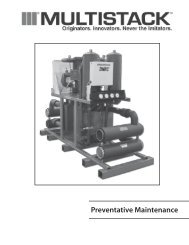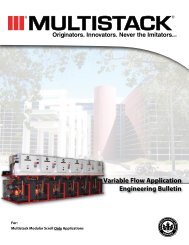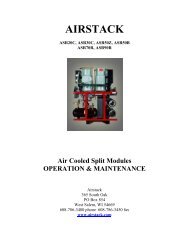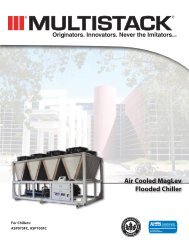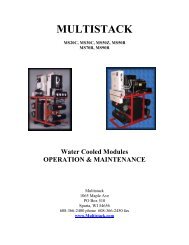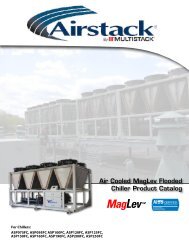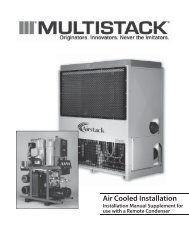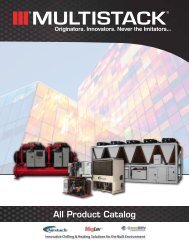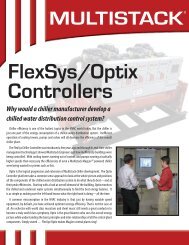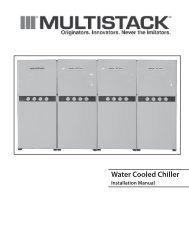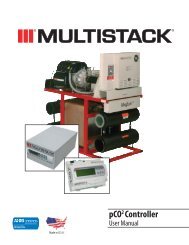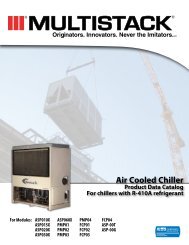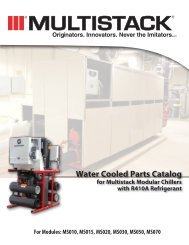Air Cooled Packaged Module - Multistack
Air Cooled Packaged Module - Multistack
Air Cooled Packaged Module - Multistack
Create successful ePaper yourself
Turn your PDF publications into a flip-book with our unique Google optimized e-Paper software.
AIR COOLED PACKAGED MODULE<br />
Operations<br />
4. Pressure readings<br />
The operating suction and discharge pressures in the modules are directly related to the temperature of the water flow, condenser temperatures, the ambient<br />
temperature and the cleanliness of the system. If a module is faulting on a High Pressure (HP) fault, you should first check to see that the fans are operating. If both<br />
fans are working check the cleanliness of the condenser coil.<br />
All ASP modules have both, a high pressure and low pressure (LP) cut out setting. Each module will cut out on HP or LP when the programmed limit in the master<br />
control is met. In addition a back up manual HP cut out switch is installed on each module.<br />
A LP fault is an indication of low refrigerant charge in the system. If a module is going out on a LP fault, check the static pressure of the system while the module<br />
is in the off mode. It will be necessary to wait for the system to warm up before checking the pressures by the gauge. If pressures are low, check the circuit for<br />
possible leaks. Call the <strong>Multistack</strong> service department for leak testing procedures.<br />
A further possible cause of a low suction temperature fault could be insufficient water flow. The strainers, filters and pump and valve settings should be checked.<br />
5. Strainer Cleaning<br />
All ASP modules have a 30 mesh filter cartridge in the chilled water inlet header. The purpose of the filter cartridge is to keep debris from entering the heat<br />
exchanger. An external “Y” or basket type strainer should also be installed as a pre-filter to the factory supplied strainers.<br />
There is no set time for cleaning the filter cartridges. The factory recommendation is that the internal filters be removed and cleaned once per year. Sometimes the<br />
filter must be removed more often if the water in the closed loop system has particulates. A good indicator that the strainers need to be cleaned is a “low leaving<br />
water temperature” fault in the module(s) near the discharge side of the chiller.<br />
a. In order to remove the in-line strainers the following steps must be performed.<br />
b. Shut down the chiller and stop the chill water pump<br />
c. Close the inlet and outlet water valves to the chiller<br />
d. Drain the water-glycol from the system and dispose properly. When the water/glycol level is below the top header the system can be safely opened.<br />
e. Remove the 4” Victaulic end cap on the last module on the discharge side. On systems with 2 banks of modules, the upper crossover pipe will also have<br />
to be removed to access the strainer in the second bank of modules. Care should be taken to close the isolation valve for that header.<br />
f. Remove the strainers and clean immediately. A hooked tool may be required to remove the strainers further in the system. This tool can be manufactured<br />
on site.<br />
g. Slowly open the bottom water isolation valve and fill the unit from the bottom up to prevent air from being trapped in the headers. Care should be<br />
taken to check for leaks.<br />
h. Restart the chill water pump and again check for possible leaks, bleed any trapped air from the system and start the chiller.<br />
6. Refrigerant charge / Evacuation<br />
All ASP modules come from the factory charged with the recommended refrigerant volume. Prior to charging, each unit is evacuated to a maximum of 150 microns<br />
and held 15 minutes. The proper refrigerant charge for each module can be found on the module data plate.<br />
On air cooled machines the proper charging procedure is by a calculated weigh-in method. Charging to a full sight glass on air cooled machines will likely result in<br />
over charging as the elbows in the liquid line as well as the liquid line solenoid valve still produce some flashing even with the correct charge. As fans are cycling<br />
the sight glass will also display some bubbling.<br />
7. Superheat / Sub cooling<br />
All ASP modules use a mechanical type expansion valve. By turning the valve adjustment clockwise superheat is increased.<br />
On each module, superheat is set at the factory during the run test. Superheat is set for 10-12°F during the test run. No further adjustments should be necessary<br />
after the module is shipped.<br />
Sub cooling is necessary in the system to prevent flash gas as the refrigerant enters the expansion valve. ASP condensers are sized and charged so that sub cooling<br />
of the liquid refrigerant will take place with no separate sub-cooler being needed. The range of sub cooling is 7-15° F.<br />
23



